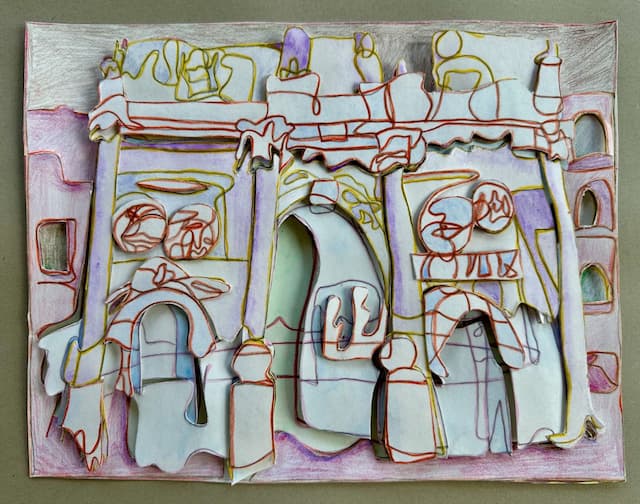Jailed for the Lord – Paul in the ‘House of Darkness’
By Elizabeth Prata
Thank goodness for historians. In ancient Rome during the last days of the Apostle Paul, Sallust and Livy, for example, wrote of the notorious jail in Rome known as the Mamertine, dubbed so in the medieval period. It’s originally known in history as the Carcer, or the Tullianum, or at least, the lower half of the underground dungeon was. History does not record for a definite fact that Peter and Paul were at different times held there, but tradition and Roman practice indicate it was a strong possibility.
This essay is constructed in three sections:
Section 1: The prison itself. What was it like?
Section 2: Paul in Prison
Section 3: Facing Death

What was the Mamertine Prison like?
The Mamertine prison was a prison in the Roman Forum where high-profile prisoners were kept, usually so they could be marched through the Roman streets during a triumph parade. High ranking commanders captured during war and other famous prisoners’ names are recorded on a plaque at the entrance. Since Paul was a significantly known public figure, it’s likely when he was imprisoned in Rome, this was the place he was kept.
The prison was deliberately constructed in the middle of the city and placed in the middle of that, into the Roman Forum, as a symbol of Rome’s power, authority, and as a warning. Crime had begun to rise as the city grew, and the Emperors wanted its citizenry to heed the consequence of crime. Hence the jail was visible and constructed so as to be fearsome.
Interestingly, Roman law did not consider the imprisonment itself as a punishment. Jails were simply a place to hold the captured or the criminals until execution, which was the punishment. Mamertine was a place of detention until execution. Barbarian Commanders captured in war were paraded and then strangled publicly, for example. Roman citizens, if unfortunate enough to have been detained for a crime, were taken outside the city on the Ostian Way and beheaded there, usually in private. Privacy in execution was a way to give a Roman Citizen his last dignity. Non-Romans were killed by any method; for example, sent to the beasts, used to the death in gladitorial games, or crucified as Peter was (tradition says, upside down). These executions were public for the spectacle of Roman power and for the amusement of its citizens.

The Mamertine, or Tullianum prison was a two-story underground prison. The upper chambers had light and air and was drier. The lower, which prisoners were let down through a hole for their fate, was dank. Historians say the word tullius meant a jet of water and since the prison was originally built as a cistern, this signifies the origin of the name. When the 6th emperor of Rome Servius Tullius arose, the origin story shifted to claim his name as the name of the jail. Below the well or cistern ran the sewer known as the Cloaca Maxima. Seepage from the sewer into the cells just above was common. In fact, they used to flush out the corpses of the incarcerated dead to the Tiber River in this way.
Once the door was shut there was little air, no light, and the cell was steaming hot. Just the name of the Mamertine drew shudders, as in this account from historian Sallust-
“There is a part of the prison which is called the Tullianum, where you ascend a short way on the left. The Tullianum is sunk into the earth about 12 feet and is constructed of stone walls on all sides; above this is a room with a ceiling of vaulted stone. Foul from neglect, darkness, and stench, it is an altogether terrifying sight. … Sallust described “Its appearance is disgusting and vile by reason of the filth, the darkness and the stench.” Sallust, War against Catiline 55. “Execution of Prisoners.”
Prisoners who were held for trial were called in carcer from which we get the word incarcerated. If you were in the Mamertine prison, you were considered as dead. Sometimes, in fact, they threw you down to the lower cell and starved you to death. What a way to go, in the dark, forgotten, hungry, alone, and then you die the painful slow death of starvation, knowing your ignoble corpse will be flushed into the sewer as waste.
Paul in prison- what do the scriptures say?
Paul was jailed numerous times and in a variety of conditions. His first was at Philippi, where he’d delivered a slave girl of her demon of divination and the owner was upset his method of income was gone. This was around 51AD. Paul (and Silas’) release was a supernatural event accompanied by an earthquake and an instant loosening of all the bonds and chains. The jailer was converted, and the next day the magistrates came and let Paul and Silas go (but asked them to leave the city). Paul went to Lydia’s house. (Acts 16:22-40).
Paul’s second jailing that we know of occurred in Jerusalem. It was prophesied beforehand that he would be jailed, (Acts 21:11) but Paul pressed on, knowing at the outset that Jesus had said Paul was to suffer mightily for the Name. (Acts 9:16). Jews, jealous of Paul, claimed (wrongly) that Paul was allowing Gentiles into the Jews-only part of the Temple, and stirred up a riot. (Acts 21:28). This was AD 57. Paul was removed to Caesarea for his safety, kept another two years, sent to Rome under house arrest around AD60. He was released in 62AD.
Paul’s last jailing was likely at the infamous Mamertine prison. He had been deserted. He knew this was the end. He had written before that he had learned to be content in whatever circumstances he found himself in by God’s providence. He had learned he could do all things through Christ. (Philippians 4:11-13). Whether enjoying a comfortable house imprisonment attended to by family, whether free and dining at Lydia’s in fellowship with the saints, or hunkered down in the sewage at Mamertine, hungry and alone. We do not know if the Lord visited Paul at the end, but we do know the Lord visited Paul at other times in his jailings, like in Acts 23:11. Bible Knowledge Commentary says,
23:11. The importance of this vision was not only in its comfort and encouragement (cf. 18:9–10) but also in the confirmation it gave of Paul’s plans to go to Rome. The gospel of Christ would literally go from Jerusalem to Rome by means of the Apostle Paul. This was the fourth vision the Lord gave Paul (cf. 9:4–6; 16:9; 18:9–10).Toussaint, S. D. (1985). Acts. In J. F. Walvoord & R. B. Zuck (Eds.), The Bible Knowledge Commentary: An Exposition of the Scriptures (Vol. 2, p. 420). Wheaton, IL: Victor Books.
Facing Death
But in reality, I think it must have been hard to maintain a positive attitude in that place. Only Luke was with him, which must have been a comfort. (2 Timothy 4:11). Paul hopes to see Timothy and also Mark. Paul was a super-Christian, but still a man. He had been buoyed personally by Jesus many times, supported by family at times, and enjoyed within his circle of beloved friends. But what thoughts go through a man’s mind when sitting in a jail cell knowing the end has come? He longed to be with Jesus, that is certain. But he just have wondered if his actual death would be prolonged or painful. He must have wondered how long he would languish in that dank place. He had been blessed with glimpses of ‘the other side,’ but must have wondered what would it really be like to be with Jesus eternally. Here is A.T. Robertson’s The International Standard Bible Encyclopaedia entry of the end.
“When Paul writes again to Timothy he has had a winter in prison, and has suffered greatly from the cold and does not wish to spend another winter in the Mamertine (probably) prison (2 Tim 4:13, 21). We do not know what the charges now are. They may have been connected with the burning of Rome. There were plenty of informers eager to win favor with Nero. Proof was not now necessary. Christianity is no longer a religio licita under the shelter of Judaism. It is now a crime to be a Christian. It is dangerous to be seen with Paul now, and he feels the desertion keenly (2 Tim 1:15 ff; 4:10). Only Luke, the beloved physician, is with Paul (4:11), and such faithful ones as live in Rome still in hiding (4:21).” [Robertson’s The International Standard Bible Encyclopaedia entry continues->]
“Paul hopes that Timothy may come and bring Mark also (4:11). Apparently Timothy did come and was put into prison (He 13:23). Paul is not afraid. He knows that he will die. He has escaped the mouth of the lion (2 Tim 4:17), but he will die (4:18). The Lord Jesus stood by him, perhaps in visible presence (4:17). The tradition is, for now Paul fails us, that Paul, as a Rom citizen, was beheaded on the Ostian Road just outside of Rome. Nero died June, 68 AD, so that Paul was executed before that date, perhaps in the late spring of that year (or 67). Perhaps Luke and Timothy were with him. It is fitting, as Findlay suggests, to let Paul’s words in 2 Tim 4:6–8 serve for his own epitaph. He was ready to go to be with Jesus, as he had long wished to be (Phil 1:23).”
Source- Robertson, A. T. (1915). Paul, the Apostle. In J. Orr, J. L. Nuelsen, E. Y. Mullins, & M. O. Evans (Eds.), The International Standard Bible Encyclopaedia (Vol. 1–5, p. 2287). Chicago: The Howard-Severance Company.
And so, Jesus gathered Paul to Himself to enjoy eternal peace and rest after so much suffering for the cause. Of all people, we can say of Paul, “Rest in Peace, brother”.
Sources and further reading:
Visit Rome: The Mamertine Prison








